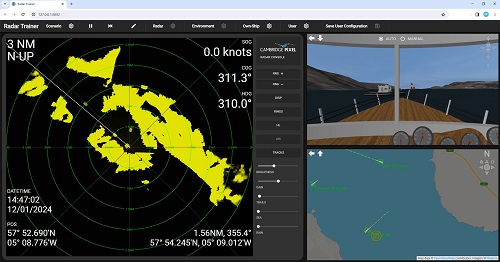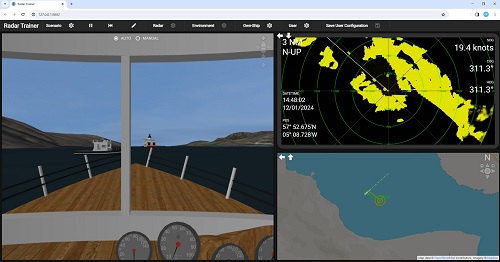

Overview
Simulate the Operation of Small Boat Radars
Compact, low-cost dome radars such as those from Furuno, JRC, Raymarine & Simrad, are now commonplace on small boats and sailing yachts.
The proper use of these marine radar systems can greatly assist in situations of restricted visibility and reduce the risk of collision, helping to ensure the safety of lives at sea.
SPx Radar Trainer can be used as a computer-based training (CBT) package for PPI display familiarisation and user training for marine radar operators.
3D Virtual Training Platform for Radar Training Course Instructors
Whilst primarily designed to assist with the training of skippers of small leisure craft, SPx Radar Trainer may also be deployed for the training of masters and bridge crews operating larger vessels in coastal, offshore and open-water ocean environments.
The platform is highly-customisable and offers a multi-view browser based GUI with a realistic PPI display, overlay track symbols and background charts/maps. The realistic 3D rendered world view includes environmental settings.
Two-level access control includes student mode and instructor mode, which supports the customisation and creation of realistic scenarios.
Key Interface Features
A modern, customisable, 3D virtual training platform.
■ Browser-Based GUI
SPx Radar Trainer has a comprehensive browser-based graphical user interface (GUI), which includes three simultaneous views of the simulation: “Radar View”, “World View” and “Ship View”. The GUI has a tiled layout, with a large primary view window and two, smaller, secondary view windows. Any of the views may be swapped or selected as the primary, through simple GUI controls.
■ Radar View Window
The trainer’s Radar View displays a highly realistic PPI (plan position indicator) radar picture with a fading/rotating sweep line. It closely mimics a typical small boat radar display with similar layout, controls and functionality. As a scenario is run, information is updated in real-time and controls are provided to allow the student to toggle overlay graphics such as range rings, heading line, AIS symbols/track labels and trail dots.
The GUI also presents controls for range scale, display mode (North-Up, Heading-Up and Course-Up), brightness and gain, as well as for sea clutter and rain clutter suppression, providing a realistic user experience.
■ World View Window
World View displays own ship and track symbols on top of a background map/chart. The view centre and zoom level can be adjusted by using the mouse.
Mouse-clickable view control buttons are also provided. Instructors have access to a hidden sidebar menu, which is used to determine own ship behaviour for the simulation.
■ Ship View Window
SPx Radar Trainer’s Ship View shows own ship in a fully 3D rendered scene. Switchable views are provided, with the default view being the view to fore, which closely mimics the Skippers view from bridge. The view can be changed to show the rendered scene from the port and starboard sides, as well as the view to aft. A bird’s-eye view from a point behind own ship, facing the rear of the vessel (stern) and looking ahead is also selectable.
The Ship View window allows the student to select Auto or Manual for how own ship is controlled. In Auto mode, the vessel’s movement is determined by the scenario configured by the course instructor. In Manual mode, the student is able to use on-screen controls to pilot the boat. An overlaid, on-screen helm is provided for the student to steer the boat. Alongside this is a virtual throttle slider, which is used to adjust forward or reverse thrust, as well as back to idle/stop.
Features
■ Highly-customisable 3D virtual training platform for small boat radars
■ Computer-based training package for configuration and deployment by course instructors
■ Simultaneous multi-view browser based GUI
■ Realistic PPI radar picture with fading/rotating sweep line
■ Supports display of overlay track symbols and background charts/maps
■ Realistic 3D rendered world view
■ On-demand access to worldwide mapping via built-in Mapbox plugin (uses OpenStreetMap data)
■ Environmental settings for time of day, fog level and weather conditions
■ Instructor mode supports customisation and creation of realistic scenarios
■ Two-level access control: “Instructor” and “Student”